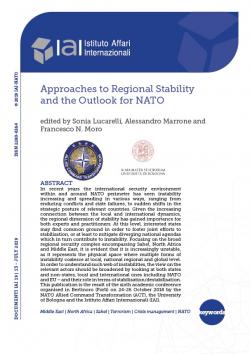Approaches to Regional Stability and the Outlook for NATO
In recent years the international security environment within and around NATO perimeter has seen instability increasing and spreading in various ways, ranging from enduring conflicts and state failures, to sudden shifts in the strategic posture of relevant countries. Given the increasing connection between the local and international dynamics, the regional dimension of stability has gained importance for both experts and practitioners. At this level, interested states may find common ground in order to foster joint efforts to stabilisation, or at least to mitigate diverging national agendas which in turn contribute to instability. Focusing on the broad regional security complex encompassing Sahel, North Africa and Middle East, it is evident that it is increasingly unstable, as it represents the physical space where multiple forms of instability coalesce at local, national regional and global level. In order to understand such web of instabilities, the view on the relevant actors should be broadened by looking at both states and non-states, local and international ones including NATO and EU – and their role in terms of stabilisation/destabilisation.
This publication is the result of the sixth academic conference organised in Bertinoro (Forlì) on 24-26 October 2018 by the NATO Allied Command Transformation (ACT), the University of Bologna and the Istituto Affari Internazionali (IAI).
-
Details
Brussels/Rome, NATO/IAI, July 2019, 116 p. -
In:
-
Issue
19|13
Introduction, by Sonia Lucarelli, Alessandro Marrone and Francesco N. Moro
The metrics of stability: A multidimensional perspective
Organised crime, corruption and illegal migration: what implications for defence capacity building?
Instability factors and international terrorism: the outlook for international organisations
References
Working Group I
1. Security and Stability for Whom? Concepts and Observables, by Andrea Ruggeri
Defining stability
Stability: power, uncertainty and identity
Political violence and stability
The risk of negative definition
Stability and International Relations theory
A working definition and levels of analysis
Measurements and trends
Security and stability for the citizens
Security and stability for a domestic regime
Security and stability for international actors
Data issues to keep in mind
Final remarks
References
2. Disaggregating Measures of Political (In)stability: Lessons from Electoral Violence, by Ursula Daxecker
Measuring (in)stability in international relations
Why electoral instability matters
Describing electoral instability
The benefits of disaggregation – Evidence from India and Nigeria
Beyond disaggregation: linking micro and macro
Conclusion
References
3. Report of the Working Group I: Metrics of Stability in a Multi-Dimensional Perspective, by Stefano Costalli
How to measure “stability”? The state of the art
Mutable situation on the ground, mutable metrics
Proposals to improve the metrics of stability
Conclusion
Working Group II
4. Organised Crime and Political Instability in the Sahel–Sahara Region, by Francesco Strazzari
The criminal phantom in the Sahel region?
Intimate connections as governance on the cheap
Conclusion
References
5. A Development Research Perspective on Addressing Irregular Migration from Sub-Saharan Africa: Implications for Defence Institution Building and Beyond, by Benjamin Schraven
European efforts in development cooperation and migration control to address irregular migration from Africa
Migration and development – a “positive” relationship
It is not only the economy, stupid: Complex causes of (irregular) migration and forced displacement
Conclusion
References
6. Report of the Working Group II: Defence Institution Building and the Challenges of Organised Crime, Corruption and Illegal Migration, by Enrico Fassi
Ongoing efforts and lessons learned
Implications for NATO
Working Group III
7. The Regional Security Complex and a Zero-Sum Game Approach: Implications for NATO, by Dario Cristiani
The horizontal contagion: Fragmentation and pluralisation in North Africa and the Middle East
The vertical contagion: The greater North Africa security complex
Exporting divisions? Europe and the increasing competition in the area
NATO and the evolving reality of the Mediterranean
Conclusion
References
8. The Regional Security Complex and the Drivers of Terrorism, by Vincent Durac
The regional security complex in the Middle East and North Africa – Instability, conflict and international terrorism
Drivers of radicalisation and terrorism in the MENA region
The response of the European Union to terrorism, radicalisation and instability in the MENA region
Conclusion
References
9. Report of the Working Group III: Middle East and North Africa – Instability Factors, Counter Terrorism and International Organisations’ Coordination, by Alessandro Marrone
State of the art in the region
Implications for a possible NATO role
List of Acronyms



